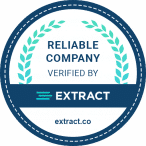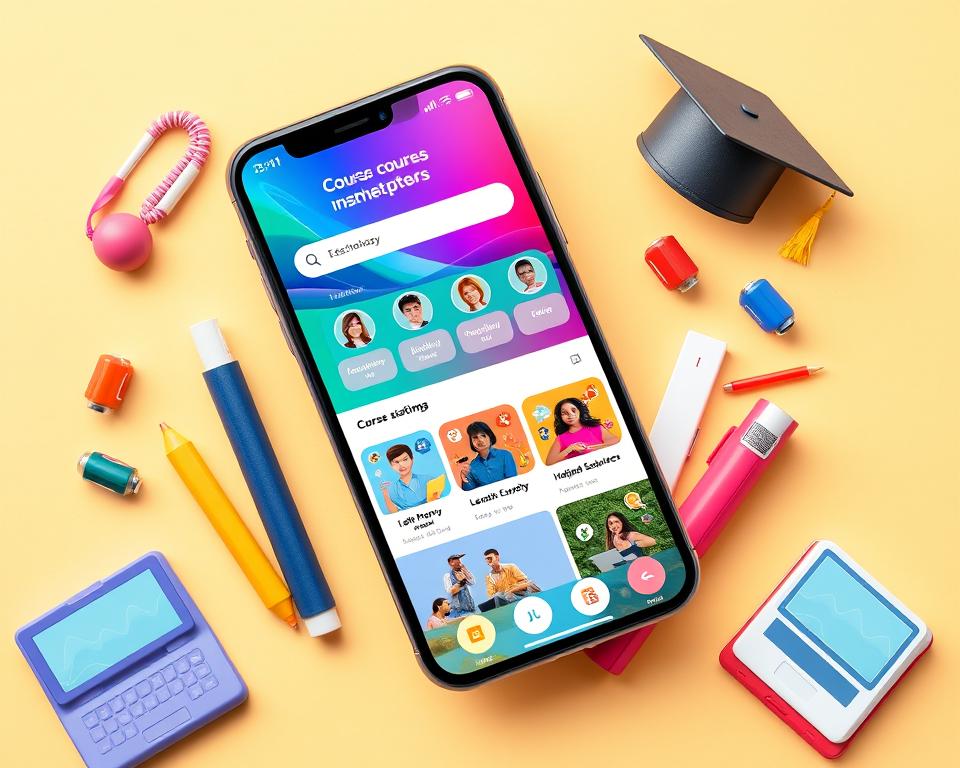The world of education is changing fast, and online learning platforms are in high demand. Developing a strong course marketplace app is key for both teachers and students. This guide will cover the important steps and best practices for making a successful app.
Course marketplace apps can change how we learn by using educational technology. They connect teachers with students, making learning better and more fun. Creating such an app needs a deep understanding of the tech, the market, and what users want.
Table of Contents
Key Takeaways
- Understand the course marketplace ecosystem and the key players in the educational technology industry.
- Identify the market demand and opportunities for a course marketplace app.
- Incorporate essential features and functionalities to create a comprehensive and user-friendly platform.
- Ensure robust user authentication and security measures to build trust and safeguard sensitive data.
- Develop a content management system that enables efficient course creation, organization, and media handling.
Understanding the Course Marketplace Ecosystem
The world of online education has changed a lot in the last ten years. Now, we have many players in the field. From MOOC platforms like Coursera and edX to LMS providers with full learning management solutions, the market is now diverse and complex.
Key Players in Educational Technology
Big names in online course marketplaces like Udemy, Skillshare, and Udacity have become well-known. They offer a wide range of courses in different subjects. These platforms let teachers share their knowledge and help students learn in a flexible way.
Market Demand and Opportunities
The pandemic has made online learning more popular than ever. This has led to a big increase in demand for edtech ecosystem solutions. As people want to learn new skills, there are more chances for MOOC platforms, LMS providers, and online course marketplaces to grow and meet the needs of today’s learners.
Current Industry Trends
The edtech ecosystem is moving towards more personalized learning. It’s also using artificial intelligence and machine learning to improve how content is delivered. And, there’s a focus on making learning accessible on mobile devices, as students like to learn on the go.
“The future of education lies in the seamless integration of technology, empowering learners to access knowledge and skills at their fingertips.”
| Company | Type | Key Offerings |
|---|---|---|
| Coursera | MOOC Platform | Online courses, Specializations, Degrees |
| Udemy | Online Course Marketplace | Vast catalog of courses, Instructor-led learning |
| Canvas | LMS Provider | Comprehensive learning management system, Collaboration tools |
Essential Features for Course Marketplace Applications
Creating a top-notch course marketplace app needs a mix of key features. These features meet the needs of teachers and students. As online learning grows, these features are key to making a platform both fun and easy to use.
User Profiles and Course Catalog
A strong user profile system is the base of any course marketplace app. It lets teachers share their skills and students find a wide course catalog that matches their interests. Detailed profiles help show off achievements, qualifications, and teaching styles. This builds trust and credibility.
Enrollment and Payment Systems
Smooth enrollment and payment systems are crucial for success. An easy enrollment system should help students sign up without hassle. It should also offer secure payment options. A reliable payment gateway ensures safe financial dealings for both teachers and students.
Review and Rating System
A good review and rating system helps students make better choices. It lets users share their thoughts on courses, teachers, and the platform. This feedback helps learners choose wisely and teachers improve their teaching.
Interactive Learning Tools
Interactive tools make learning fun and engaging. Features like video chats, forums, quizzes, and multimedia content are great. They create a lively learning space, boosting student interest and retention.
| Feature | Description | Key Benefits |
|---|---|---|
| User Profiles | Comprehensive profiles for instructors and students | Builds trust, showcases expertise, and facilitates discovery |
| Course Catalog | Diverse selection of courses across various subjects | Allows students to find relevant and personalized learning opportunities |
| Enrollment System | Seamless registration and payment processing | Provides a frictionless user experience and ensures secure transactions |
| Review and Rating System | Enables users to provide feedback on courses and instructors | Helps students make informed decisions and instructors improve their offerings |
| Interactive Learning Tools | Features like video conferencing, discussion forums, and multimedia content | Enhances student engagement, collaboration, and knowledge retention |
By adding these key features, a course marketplace app can become a lively place for learning. It meets the needs of teachers and students, making learning fun and effective.
Technical Requirements and Stack Selection
Choosing the right tech stack is key for a strong course marketplace app. It involves picking the best web development frameworks, backend technologies, and database architecture. These choices help the app work well and grow.
Frontend Development Tools
For the frontend, React, Angular, and Vue.js are top picks. They help build user-friendly interfaces. This makes the app better for both teachers and students.
Backend Technologies
For the backend, Node.js, Python, or PHP are great. They handle server tasks, API work, and important app functions. These options are safe and can grow with the app.
Database Architecture
The right database architecture is vital for managing data. You can use MySQL, PostgreSQL, MongoDB, or Couchbase. They help make the app’s infrastructure strong and efficient.
By picking the right tech stack, developers can make a course marketplace app. It will have lots of features and can handle more users.
User Authentication and Security Measures
In the world of course marketplace apps, data protection and user security are top priorities. To keep your platform safe and private, you need strong authentication systems and security measures.
Secure login is a key part of user security. Using SSL/TLS encryption helps protect user passwords and keeps data safe. Multi-factor authentication adds more security by checking user identity through SMS, email, or biometrics.
Following GDPR rules is also vital for apps that reach users worldwide. This means having strong data protection steps, like secure data storage and clear privacy policies.
- Implement SSL/TLS encryption for secure login and data transmission
- Incorporate multi-factor authentication to enhance user security
- Ensure GDPR compliance for user data protection and privacy
- Regularly monitor and update security protocols to stay ahead of evolving threats
By focusing on user security, you can create a course marketplace app that’s both easy to use and trustworthy. This approach to security is key to making your platform a go-to place for both teachers and students.
“Securing user data should be the foundation of any successful course marketplace application. Failing to do so can lead to serious consequences, both for the platform and its users.”
Course Content Management System Design
Creating a strong CMS (Content Management System) is vital for organizing and sharing course materials. It should handle content, file storage, and media handling well.
Content Organization Structure
A good content structure is essential for easy access and navigation. Use a folder system to organize content by subject and topic. This makes it easy for instructors to upload and manage their materials.
File Storage Solutions
Good file storage is key for all types of course materials. Using cloud storage like Google Drive or Dropbox is a smart choice. It keeps files safe and easy to access for everyone.
Media Handling Capabilities
Today, multimedia is important for learning. The CMS should handle videos, audio, and interactive content well. This ensures a great learning experience for students.
| Feature | Benefit |
|---|---|
| Hierarchical Content Organization | Intuitive navigation and easy access to course materials |
| Cloud-based File Storage | Secure and scalable storage for diverse file formats |
| Multimedia Integration | Engaging and interactive learning experience for students |
A well-designed CMS improves learning by organizing content, storing files, and integrating multimedia. It makes learning better for everyone involved.
Payment Gateway Integration and Monetization
Creating a successful course marketplace app needs smooth e-commerce integration and smart monetization plans. It must offer safe and easy payment choices. Also, it should have new subscription models and revenue sharing ways.
A trusted payment gateway is key. It makes secure transactions and keeps users’ financial info safe. The app should let users pay in many ways, like with cards or digital wallets.
Teachers want fair revenue sharing deals. They want to make a good amount from course fees. The app should let teachers set prices in different ways. This includes one-time fees, subscriptions, and bundles.
| Feature | Benefit |
|---|---|
| E-commerce integration | Seamless payment processing and secure transactions |
| Subscription models | Recurring revenue streams and customer loyalty |
| Revenue sharing | Fair compensation for instructors and platform sustainability |
| Secure transactions | Trusted payment gateways and data protection |
By meeting the payment and money-making needs of teachers and students, the app can grow. It can become a place where everyone can learn and grow together.
Building the Instructor Dashboard
Online courses are more popular than ever. Instructors need tools to manage their courses well. The instructor dashboard is a key tool. It offers analytics, course creation tools, and ways to manage earnings.
Analytics and Reporting Tools
Performance metrics and course analytics are vital. They help instructors see how well their courses are doing. The dashboard should make it easy to see student engagement, course completion, and earnings.
This information helps instructors make better decisions. They can improve their courses and marketing plans based on the data.
Course Creation Interface
A good course creation interface is important. It makes it easier to create and publish courses. Instructors need tools to organize their courses, upload content, and set up course settings.
This helps instructors focus on teaching. They don’t have to worry about the technical stuff.
Revenue Management System
Instructors need a way to track their earnings. The dashboard should let them see sales data, payouts, and earnings trends. This gives them the information they need to make smart financial decisions.
| Feature | Description |
|---|---|
| Performance Metrics | Detailed analytics on student engagement, course completion, and revenue generation |
| Course Creation Tools | Intuitive interface for organizing curriculum, uploading content, and managing course settings |
| Earnings Tracking | Centralized system for monitoring sales data, payouts, and revenue trends |
By adding these features to the instructor dashboard, course creators can work more efficiently. They get valuable insights and can make informed decisions to improve their courses.
Student Learning Interface Development
Creating an engaging and easy-to-use interface for students is key in a course marketplace app. The interface should make learning better and help students, teachers, and content connect well.
User experience design is at the heart of this. It means making a design that looks good and is easy to use. This design should help students find and enjoy their courses smoothly.
Learning progress tracking is also important. Students should be able to see how they’re doing and track their progress. This helps them stay on track and lets teachers give better feedback.
Finally, the interface should give out course completion certificates. These certificates prove what students have learned. They’re great for school or work.
By focusing on design, tracking, and certificates, the interface can really help students. It makes learning fun, keeps students motivated, and helps them succeed in their courses.
“Designing a student-centric learning interface is not just about aesthetics, but about creating an experience that nurtures growth, motivation, and a sense of accomplishment.”
Search and Discovery Functionality
Creating a great course marketplace app needs a strong search and discovery system. This helps students find the courses they need. Search optimization, category navigation, and recommendation engines are key to a good user experience.
Filter Implementation
A detailed filter system lets students narrow down their searches. They can look for courses by subject, level, duration, price, and reviews. This makes it easy for them to find courses that match their goals and likes.
Search Algorithm Design
Creating a search algorithm that gives accurate and personalized results is vital for course discovery. Using advanced methods like natural language processing, machine learning, and analyzing user behavior helps. This way, the search function can suggest courses that are just right for students.
Category Management
Organizing courses into clear categories and subcategories makes category navigation smooth for students. This structure boosts the user experience and search optimization. It makes it simpler for users to find courses they’re interested in.
In the end, combining strong filters, smart search algorithms, and easy category management builds a strong recommendation engine. This engine helps students find the perfect courses for their educational goals.
Mobile Responsiveness and Cross-Platform Compatibility
In today’s world, people use many devices to access content. It’s key to make a course marketplace app that works well on all devices. This way, users have a smooth experience, no matter what they’re using.
The app should have a responsive design approach. This means it adjusts to fit different screens and sizes. It uses flexible grids and CSS media queries to look good on phones, tablets, and computers.
Also, the app can be a native app or a hybrid app, based on what you need and who you’re making it for. Native apps are made for specific platforms like iOS or Android. They work better and offer special features. Hybrid apps, however, can run on many platforms. They’re cheaper and work well on different devices.
| Comparison | Native Apps | Hybrid Apps |
|---|---|---|
| Performance | High | Moderate |
| User Experience | Excellent | Good |
| Cross-Platform Compatibility | Limited | High |
| Development Cost | Higher | Lower |
By focusing on responsive design and cross-platform compatibility, you make sure everyone can use the app easily. This is true for both instructors and students, no matter their device or operating system.
Testing and Quality Assurance Procedures
Creating a top-notch course marketplace app needs a thorough testing plan. This ensures the app works well, users are happy, and everyone has a smooth experience. The key steps include beta testing, user acceptance testing, and performance optimization. These steps help find and fix any bugs or issues.
Beta testing lets a small group of users try the app. They give feedback on how it works, looks, and what can be better. This feedback loop helps make the app better before it’s fully released.
Next, the user acceptance testing (UAT) phase is crucial. Here, different users check the app to see if it meets their needs. This step makes sure the app works as expected and improves the user experience.
While testing, the team also focuses on making the app fast and efficient. They work on database queries, caching, and watch system metrics. This ensures the app is quick, even when lots of people are using it.
Lastly, a good bug tracking system is key. It helps find, sort, and fix any problems that come up. This keeps the app stable and reliable, giving users a great experience.
| Testing Procedure | Objective | Key Considerations |
|---|---|---|
| Beta Testing | Gather user feedback and identify areas for improvement | Diverse user group, iterative feedback loop |
| User Acceptance Testing | Validate application’s compliance with requirements | Comprehensive test cases, user experience validation |
| Performance Optimization | Ensure fast and responsive application | Database optimization, caching strategies, system monitoring |
| Bug Tracking | Identify and resolve issues to maintain stability | Effective issue tracking, prioritization, and resolution |
By following these strict testing and quality checks, the team can make a course marketplace app that meets high standards. It will provide a smooth experience and pave the way for success.
Deployment and Maintenance Strategy
Creating a course marketplace app is just the start. To keep it successful, you need a solid plan for deployment and upkeep. This guide will help you set up your cloud infrastructure, keep an eye on performance, and handle updates.
Cloud Infrastructure Setup
Picking the right cloud platform is key for smooth cloud deployment and scalable server management. Think about cost, reliability, and ease of use when choosing a cloud provider. AWS, Google Cloud, and Microsoft Azure are popular choices. Make sure your infrastructure is secure and can handle lots of users and content.
Performance Monitoring
It’s important to keep an eye on your app’s performance to ensure a good user experience. Use analytics tools to track things like page load times and server use. Check these metrics often and fix any problems quickly to keep your app running smoothly.
Update Management
Keeping your app updated with new features and security patches is crucial. Create a clear version control plan to manage updates smoothly. Test new features well to avoid any problems.
| Cloud Service Provider | Key Features | Pricing Model |
|---|---|---|
| Amazon Web Services (AWS) |
|
Pay-as-you-go, with various pricing tiers and discounts |
| Google Cloud Platform |
|
Combination of pay-as-you-go and committed usage discounts |
| Microsoft Azure |
|
Pay-as-you-go, with various pricing options and enterprise agreements |
By carefully planning your deployment and maintenance strategy, you can keep your app reliable, secure, and up-to-date. This ensures a great experience for both teachers and students.
Conclusion
In the world of edtech, creating a successful course marketplace app is key. It shapes the future of online learning. This guide helps instructors and entrepreneurs understand the educational tech world. They can meet market needs and use current trends.
This article covers the basics for a strong course marketplace platform. It talks about secure login, content management, and easy payments. Each part is important for a good user experience.
The need for flexible, personalized online learning is growing. Course marketplace apps must adapt to meet these needs. By focusing on edtech innovation and user needs, they can lead in the course marketplace success. This changes how we learn in the digital age.



















